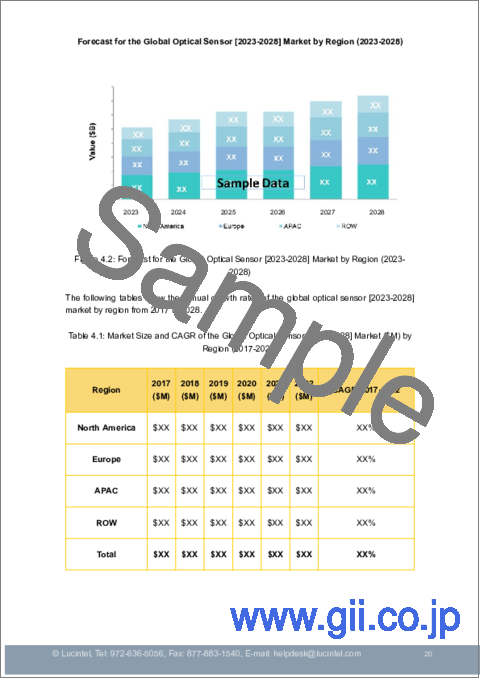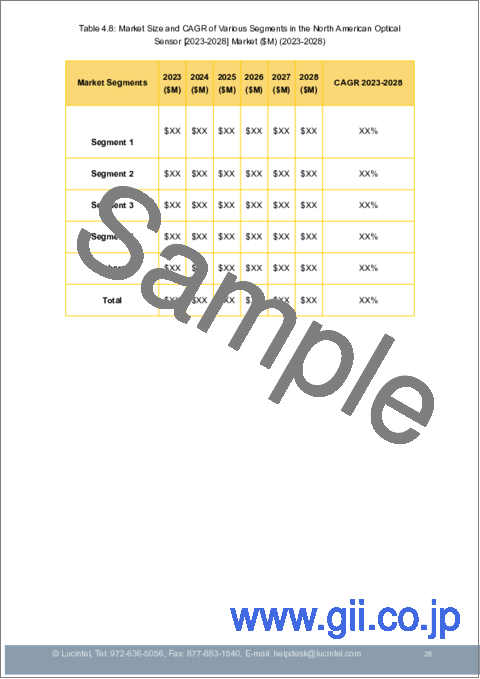|
|
市場調査レポート
商品コード
1263812
光センサーの世界市場 (2023-2028年):動向・成長機会・競合分析Optical Sensor Market: Trends, Opportunities and Competitive Analysis [2023-2028] |
||||||
|
● お客様のご希望に応じて、既存データの加工や未掲載情報(例:国別セグメント)の追加などの対応が可能です。 詳細はお問い合わせください。 |
|||||||
| 光センサーの世界市場 (2023-2028年):動向・成長機会・競合分析 |
|
出版日: 2023年03月01日
発行: Lucintel
ページ情報: 英文 150 Pages
納期: 3営業日
|
- 全表示
- 概要
- 目次
世界の光センサーの市場規模は、2023年から2028年にかけて8.7%のCAGRで推移し、2028年には203億米ドルの規模に成長すると予測されています。
CE製品への光センサーの搭載の増加、インダストリー4.0、IoT、クラウドコンピューティングのトレンドの高まり、スマートフォンのセキュリティ対策への需要の高まりなどの要因が同市場の成長を推進しています。
当レポートでは、世界の光センサーの市場を調査し、市場背景・概要、市場規模の推移・予測、各種区分・地域/主要国別の内訳、市場シェア、競合情勢、成長機会・戦略分析、主要企業のプロファイルなどをまとめています。
目次
第1章 エグゼクティブサマリー
第2章 世界の光センサー市場:市場力学
- イントロダクション・背景・分類
- サプライチェーン
- 産業の推進因子と課題
第3章 市場動向・予測分析
- マクロ経済の動向・予測
- 世界の光センサー市場の動向・予測
- 世界の光センサー市場:製品タイプ別
- 環境光・近接センサー
- 光ファイバーセンサー
- イメージセンサー
- 光電センサー
- 世界の光センサー市場:出力別
- アナログ
- デジタル
- 世界の光センサー市場:統合別
- ディスクリート
- 複合
- 世界の光センサー市場:用途別
- バイオメトリックおよび環境光センシング
- 生体センシング
- 光ファイバー化学センシング
- 温度センシング
- 放射線検出
- 変位・位置センシング
- 音響フィールド・振動センシング
- 圧力・ひずみセンシング
- 地理測量
- 計測
- 世界の光センサー市場:エンドユーザー産業別
- 航空宇宙・防衛
- 自動車
- ビルオートメーション
- 化学
- CE製品
- 食品・飲料
- 製造
- マテリアルハンドリング
- 医療
- セキュリティ・監視
第4章 市場動向・予測分析:地域別
- 世界の光センサー市場:地域別
- 北米
- 欧州
- アジア太平洋
- その他の地域
第5章 競合企業の分析
- 製品ポートフォリオ分析
- 運用統合
- ポーターのファイブフォース分析
第6章 成長機会と戦略分析
- 成長機会分析
- 新たな動向
- 戦略分析
第7章 主要企業プロファイル
- ROHM
- Rockwell Automation
- SICK AG
- Vishay Intertechnology
- Honeywell
Optical Sensor Market Trends and Forecast
The future of the global optical sensor market looks promising with opportunities in the aerospace and defense, automotive, building automation, chemical, consumer electronics, food and beverage, manufacturing, material handling, healthcare, and security and surveillance sectors. The global optical sensor market is expected to reach an estimated $20.3 billion by 2028 with a CAGR of 8.7% from 2023 to 2028. The major drivers for this market are increasing penetration of optical sensors in consumer electronic devices and growing trend of Industry 4.0, IOT, and cloud computing; and growing demand for security measures in smartphone.
A more than 150-page report is developed to help in your business decisions. Sample figures with some insights are shown below.
Optical Sensor Market by Segment
The study includes a forecast for the global optical sensor market by optical sensor market by product type, output, integration, application, end use industry, and region, as follows:
Optical Sensor Market by Product Type [Value ($B) Shipment Analysis from 2017 to 2028]:
- Ambient Light and Proximity Sensor
- Fiber Optic Sensor
- Image Sensor
- Photoelectric Sensor
Optical Sensor Market by Output [Value ($B) Shipment Analysis from 2017 to 2028]:
- Analog
- Digital
Optical Sensor Market by Integration [Value ($B) Shipment Analysis from 2017 to 2028]:
- Discrete
- Combination
Optical SensorMarket by Application [Value ($B) Shipment Analysis from 2017 to 2028]:
- Biometric & Ambient Light Sensing
- Biomedical Sensing
- Fiber Optic Chemical Sensing
- Temperature Sensing
- Radiation Detection
- Displacement & Position Sensing
- Acoustic Field &Vibration sensing
- Pressure & Strain Sensing
- Geographical Survey
- Metrology
Optical SensorMarket by End Use Industry [Value ($B) Shipment Analysis from 2017 to 2028]:
- Aerospace and Defense
- Automotive
- Building Automation
- Chemical
- Consumer Electronics
- Food and Beverage
- Manufacturing
- Material Handling
- Healthcare
- Security and Surveillance
Optical Sensor Market by Region [Value ($B) Shipment Analysis from 2017 to 2028]:
- North America
- Europe
- Asia Pacific
- The Rest of the World
List of Optical Sensor Companies
Companies in the market compete on the basis of product quality offered. Major players in this market focus on expanding their manufacturing facilities, R&D investments, infrastructural development, and leverage integration opportunities across the value chain. With these strategies optical sensor companies cater increasing demand, ensure competitive effectiveness, develop innovative products & technologies, reduce production costs, and expand their customer base. Some of the optical sensor companies profiled in this report include.
- ROHM
- Rockwell Automation
- SICK AG
- Vishay Intertechnology
- Honeywell
Optical Sensor Market Insights
- Lucintel forecast that photoelectric sensor will remain the largest segment over the forecast period due to the growing demand for photoelectric sensors for the industrial automation application as it helps in high precision object detection.
- Consumer electronic is expected to remain the largest segment due to the extensive use of optical sensors as an advanced technology in consumer electronics devices, such as smartphones, television, laptops, and other devices.
- North America will remain the largest region due to increasing penetration of optical sensor in industrial and commercial applications and growing demand of smart home connected devices.
Features of the Optical Sensor Market
- Market Size Estimates:Optical sensor market size estimation in terms of value ($B)
- Trend And Forecast Analysis:Market trends (2017-2022) and forecast (2023-2028) by various segments and regions.
- Segmentation Analysis:Optical sensor market size by various segments, such as by product type, output, integration, application, end use industry, and region
- Regional Analysis:Optical sensor market breakdown by North America, Europe, Asia Pacific, and the Rest of the World.
- Growth Opportunities:Analysis on growth opportunities in different by product type, output, integration, application, end use industry, and regions for the optical sensor market.
- Strategic Analysis:This includes M&A, new product development, and competitive landscape for the optical sensor market.
- Analysis of competitive intensity of the industry based on Porter's Five Forces model.
FAQ
Q1. What is the optical sensor market size?
Answer: The global optical sensor market is expected to reach an estimated $20.3 billion by 2028.
Q2. What is the growth forecast for optical sensor market?
Answer: The global optical sensor market is expected to grow with a CAGR of 8.7% from 2023 to 2028.
Q3. What are the major drivers influencing the growth of the optical sensor market?
Answer: The major drivers for this market are increasing penetration of optical sensors in consumer electronic devices and growing trend of Industry 4.0, IOT, and cloud computing; and growing demand for security measures in smartphone.
Q4. What are the major segments for optical sensor market?
Answer: The future of the optical sensor market looks promising with opportunities in the aerospace and defense, automotive, building automation, chemical, consumer electronics, food and beverage, manufacturing, material handling, healthcare, and security and surveillance sectors.
Q5. Who are the key optical sensor companies?
Answer: Some of the key optical sensor companies are as follows:
- ROHM
- Rockwell Automation
- SICK AG
- Vishay Intertechnology
- Honeywell
Q6. Which optical sensor segment will be the largest in future?
Answer:Lucintel forecast that photoelectric sensor will remain the largest segment over the forecast period due to the growing demand for photoelectric sensors for the industrial automation application as it helps in high precision object detection.
Q7. In optical sensor market, which region is expected to be the largest in next 5 years?
Answer: North America will remain the largest region due to increasing penetration of optical sensor in industrial and commercial applications and growing demand of smart home connected devices.
Q8. Do we receive customization in this report?
Answer: Yes, Lucintel provides 10% Customization Without any Additional Cost.
This report answers following 11 key questions
- Q.1. What are some of the most promising, high-growth opportunities for the optical sensor market by product type (ambient light and proximity sensor, fiber optic sensor, image sensor, and photoelectric sensor), output (analog and digital), integration (discrete and combination), application (biometric & ambient light sensing, biomedical sensing, fiber optic chemical sensing, temperature sensing, radiation detection, displacement & position sensing, acoustic field & vibration sensing, pressure & strain sensing, geographical survey, and metrology), and end use industry (aerospace and defense, automotive, building automation, chemical, consumer electronics, food and beverage, manufacturing, material handling, healthcare, and security and surveillance), and region (North America, Europe, Asia Pacific, and the Rest of the World)?
- Q.2. Which segments will grow at a faster pace and why?
- Q.3. Which region will grow at a faster pace and why?
- Q.4. What are the key factors affecting market dynamics? What are the key challenges and business risks in this market?
- Q.5. What are the business risks and competitive threats in this market?
- Q.6. What are the emerging trends in this market and the reasons behind them?
- Q.7. What are some of the changing demands of customers in the market?
- Q.8. What are the new developments in the market? Which companies are leading these developments?
- Q.9. Who are the major players in this market? What strategic initiatives are key players pursuing for business growth?
- Q.10. What are some of the competing products in this market and how big of a threat do they pose for loss of market share by material or product substitution?
- Q.11. What M&A activity has occurred in the last 5 years and what has its impact been on the industry?
Table of Contents
1. Executive Summary
2. Global Optical Sensor Market: Market Dynamics
- 2.1: Introduction, Background, and Classifications
- 2.2: Supply Chain
- 2.3: Industry Drivers and Challenges
3. Market Trends and Forecast Analysis from 2017 to 2028
- 3.1: Macroeconomic Trends (2017-2022) and Forecast (2023-2028)
- 3.2: Global Optical Sensor Market Trends (2017-2022) and Forecast (2023-2028)
- 3.3: Global Optical Sensor Market by Product Type
- 3.3.1: Ambient Light and Proximity Sensor
- 3.3.2: Fiber Optic Sensor
- 3.3.3: Image Sensor
- 3.3.4: Photoelectric Sensor
- 3.4: Global Optical Sensor Market by Output
- 3.4.1: Analog
- 3.4.2: Digital
- 3.5: Global Optical Sensor Market by Integration
- 3.5.1: Discrete
- 3.5.2: Combination
- 3.6: Global Optical Sensor Market by Application
- 3.6.1: Biometric & Ambient Light Sensing
- 3.6.2: Biomedical Sensing
- 3.6.3: Fiber Optic Chemical Sensing
- 3.6.4: Temperature Sensing
- 3.6.5: Radiation Detection
- 3.6.6: Displacement & Position Sensing
- 3.6.7: Acoustic Field &Vibration sensing
- 3.6.8: Pressure & Strain Sensing
- 3.6.9: Geographical Survey
- 3.6.10: Metrology
- 3.7: Global Optical Sensor Market by End Use Industry
- 3.7.1: Aerospace and Defense
- 3.7.2: Automotive
- 3.7.3: Building Automation
- 3.7.4: Chemical
- 3.7.5: Consumer Electronics
- 3.7.6: Food and Beverage
- 3.7.7: Manufacturing
- 3.7.8: Material Handling
- 3.7.9: Healthcare
- 3.7.10: Security and Surveillance
4. Market Trends and Forecast Analysis by Region from 2017-2028
- 4.1: Global Optical Sensor Market by Region
- 4.2: North American Optical Sensor Market
- 4.2.1: North American Optical Sensor Market by Product Type: Ambient Light and Proximity Sensor, Fiber Optic Sensor, Image Sensor, and Photoelectric Sensor
- 4.2.2: North American Optical Sensor Market by End Use Industry: Aerospace and Defense, Automotive, Building Automation, Chemical, Consumer Electronics, Food and Beverage, Manufacturing, Material Handling, Healthcare, and Security and Surveillance
- 4.3: European Optical Sensor Market
- 4.3.1: European Optical Sensor Market by Product Type: Ambient Light and Proximity Sensor, Fiber Optic Sensor, Image Sensor, and Photoelectric Sensor
- 4.3.2: European Optical Sensor Market by End Use Industry: Aerospace and Defense, Automotive, Building Automation, Chemical, Consumer Electronics, Food and Beverage, Manufacturing, Material Handling, Healthcare, and Security and Surveillance
- 4.4: APAC Optical Sensor Market
- 4.4.1: APAC Optical Sensor Market by Product Type: Ambient Light and Proximity Sensor, Fiber Optic Sensor, Image Sensor, and Photoelectric Sensor
- 4.4.2: APAC Optical Sensor Market by End Use Industry: Aerospace and Defense, Automotive, Building Automation, Chemical, Consumer Electronics, Food and Beverage, Manufacturing, Material Handling, Healthcare, and Security and Surveillance
- 4.5: ROW Optical Sensor Market
- 4.5.1: ROW Optical Sensor Market by Product Type: Ambient Light and Proximity Sensor, Fiber Optic Sensor, Image Sensor, and Photoelectric Sensor
- 4.5.2: ROW Optical Sensor Market by End Use Industry: Aerospace and Defense, Automotive, Building Automation, Chemical, Consumer Electronics, Food and Beverage, Manufacturing, Material Handling, Healthcare, and Security and Surveillance
5. Competitor Analysis
- 5.1: Product Portfolio Analysis
- 5.2: Operational Integration
- 5.3: Porter's Five Forces Analysis
6. Growth Opportunities and Strategic Analysis
- 6.1: Growth Opportunity Analysis
- 6.1.1: Growth Opportunities for the Optical Sensor Market by Product Type
- 6.1.2: Growth Opportunities for the Optical Sensor Market by Output
- 6.1.3: Growth Opportunities for the Optical Sensor Market by Integration
- 6.1.4: Growth Opportunities for the Optical Sensor Market by Application
- 6.1.5: Growth Opportunities for the Optical Sensor Market by End Use Industry
- 6.1.6: Growth Opportunities for the Optical Sensor Market Region
- 6.2: Emerging Trends in the Global Optical Sensor Market
- 6.3: Strategic Analysis
- 6.3.1: New Product Development
- 6.3.2: Capacity Expansion of the Global Optical Sensor Market
- 6.3.3: Mergers, Acquisitions, and Joint Ventures in the Global Optical Sensor Market
- 6.3.4: Certification and Licensing
7. Company Profiles of Leading Players
- 7.1: ROHM
- 7.2: Rockwell Automation
- 7.3: SICK AG
- 7.4: Vishay Intertechnology
- 7.5: Honeywell




